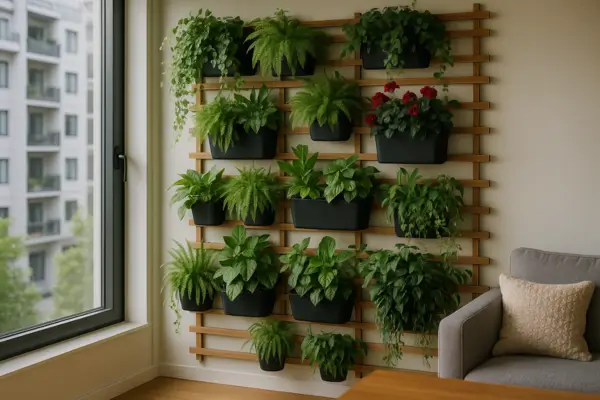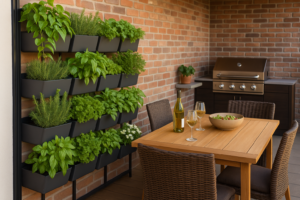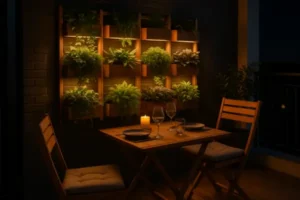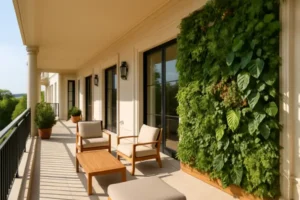Living in a compact space doesn’t mean giving up on greenery. In fact, one of the biggest vertical garden benefits is how effortlessly they adapt to apartments and small homes.
From adding natural beauty to improving air quality, vertical gardens turn unused walls into vibrant living features. They create a soothing atmosphere, even in the heart of the city.
Whether you want to grow herbs, flowers, or simply add life to a dull balcony, a modular vertical garden for gourmet balconies can be the perfect solution. Let’s understand why they work so well.
Vertical Garden Benefits: Space-Saving Solutions with Big Impact
The main advantage of vertical gardens in apartments is their incredible adaptability. They fit into the most unexpected places — like narrow hallways, structural columns, and even unused exterior walls — optimizing the space without interfering with mobility.
Why does vertical use work so well?
When space is limited, the key is to break free from the horizontal layout. Walls, often ignored, are transformed into living structures. One of the most practical vertical garden benefits is the ability to reclaim unused vertical surfaces—saving room while improving circulation, lighting, and the overall look and feel of the space.
In small apartments, this makes all the difference. A one-square-meter area can hold over 20 vertically arranged pots, while the same amount of floor space would accommodate only four or five.
Practical advantages of going vertical
Here’s how vertical gardens become a truly practical solution in everyday life:
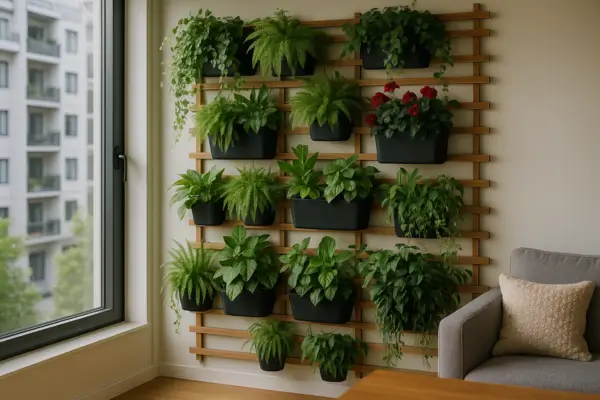
- They make floor cleaning and maintenance easier
- They make better use of natural light, since the pots are placed at different heights
- They create natural dividers between functional areas (kitchen, laundry, balcony)
- They help organize plants based on their needs (light, water, airflow)
- They can be removed or repositioned with ease
Small space, big impact
One of the most noticeable vertical garden benefits is the strong visual impact they create, often surpassing that of traditional planters or ground-level beds. The upward layout naturally draws the eye, adding a sense of height and spaciousness—even in compact environments.
Beyond structure alone, these gardens can be enhanced with subtle details like integrated lighting, decorative frames, or custom supports. These additions highlight textures and shadows throughout the day, turning your green wall into a design element that evolves with the light and the seasons.
Bring Nature Closer Without Losing Room to Move
Apartments come with space limitations, but that doesn’t mean you have to give up on green living. One of the most practical vertical garden benefits is how they bring nature closer without invading your living area. By going vertical, you create a lush atmosphere without cluttering the floor.
Using dead space wisely
Most apartment layouts include underutilized surfaces—walls, narrow corners, and structural columns. These often-overlooked areas become opportunities for vertical greenery.
Unlike traditional planters, vertical gardens don’t compete with furniture or movement. Instead, they float, freeing up your floor while adding visual depth.
Some great placement ideas include:
- Kitchen walls with indirect light
- Bathroom corners with humidity-loving plants
- Narrow balcony walls or railings
- Blank walls behind sofas or near dining tables
- Transitional areas like entryways or corridors
Smart design for multifunctional areas
A modular vertical garden for gourmet balconies blends beauty and purpose. You can grow herbs for cooking, flowers for color, and trailing plants for softness—all in one vertical system. This turns forgotten areas into high-value zones that enhance your lifestyle.
Here are a few layout ideas that work well in small spaces:
- Vertical herb garden right next to the grill
- A privacy screen made of hanging ferns and ivy
- A narrow wall garden beside your outdoor dining set
- Mixed succulents in geometric patterns for minimal balconies
- Hanging vines paired with soft lighting for evening relaxation
A flexible solution for modern renters
You don’t need to drill holes or own the place to build a vertical garden. Many freestanding or modular setups allow renters to customize without permanent changes. They’re easy to install, remove, and redesign as your style evolves.
When nature becomes part of your indoor routine—next to your morning coffee, above your reading nook, or beside your dinner table—it makes your apartment feel complete.
Better Air Quality and Natural Cooling
Indoor air can easily become stale in small apartments with limited airflow. One of the most valuable vertical garden benefits is how it naturally helps clean the air and regulate temperature—turning a decorative wall into a living, functional feature.
How plants act as silent air purifiers
Plants constantly interact with their environment. Through their leaves, roots, and even the growing medium, they absorb pollutants that are commonly found in indoor spaces—things like volatile organic compounds (VOCs) released by cleaning products, furniture, and synthetic materials.
When thoughtfully arranged in a vertical system, plants can:
- Remove harmful chemicals like formaldehyde, benzene, and trichloroethylene
- Improve humidity during dry months, reducing irritation in the eyes, skin, and throat
- Capture fine dust particles and airborne allergens
- Minimize the presence of mold spores, especially in bathrooms or kitchens
Spider plants, pothos, snake plants, peace lilies, and ferns are just a few examples of species known for their air-cleaning capabilities. Many of them thrive in vertical setups and require minimal maintenance.
Vertical gardens as natural cooling systems
In sun-exposed areas, like balconies that face west or receive intense midday light, heat can easily build up. This contributes to higher indoor temperatures, forcing air conditioners to work harder. A modular vertical garden for gourmet balconies offers a passive solution.
The greenery acts as a shield, absorbing solar radiation and creating a buffer zone between the exterior wall and the sun. That means less direct heat reaches your interior space.
In addition, plants cool the air through a process called evapotranspiration. As moisture is released from their leaves, it evaporates into the air, slightly lowering the surrounding temperature—like a natural misting system, but constant and energy-free.
Best plants for improving air and cooling your space
If your main goals are cleaner air and lower temperatures, consider adding these to your vertical garden:
- Areca palm: boosts humidity and absorbs toxins
- Boston fern: filters air and thrives in moist, semi-shaded areas
- Snake plant: tough, sculptural, and known for filtering multiple pollutants
- English ivy: excellent for airborne mold reduction
- Pothos: adapts well to various conditions and improves air purity
These species not only purify the air but also add lush texture and depth to your green wall, making your space feel fresher, cooler, and more alive.
A Natural Pause in a Fast-Paced Routine
In the middle of urban routines filled with screens, traffic, and deadlines, vertical gardens offer something rare: a natural break. Even in compact apartments, a green wall becomes a subtle but powerful shift in atmosphere.
One of the most underrated vertical garden benefits is how easily it brings a sense of calm structure into everyday life. It reconnects you to something organic, steady, and quietly dynamic.
Whether you’re cooking breakfast, stepping onto your balcony, or just passing by a living wall in the hallway, the presence of greenery softens the space. It makes the apartment feel less rigid, more balanced, and genuinely lived-in.
Small rituals that reset your environment
Tending to a vertical garden isn’t a chore—it becomes part of your rhythm. These small, hands-on moments bring physicality and awareness into your daily environment, giving your mind a place to slow down without needing to stop.
Some of the most grounding parts of vertical garden care include:
- Watering in the early morning or late afternoon
- Rotating plants based on seasonal light
- Wiping leaves or trimming dry edges
- Replanting sections with seasonal herbs or textures
- Noticing growth and change over time
These micro-activities are simple, brief, and naturally engaging. Over time, they transform how you relate to your space.
A home that feels more alive
A modular vertical garden for gourmet balconies doesn’t just make your apartment look better—it makes it feel more dynamic. As plants grow, shift, and interact with light and seasons, your home evolves along with them. This sense of movement and rhythm adds character to any apartment, whether large or small.
It’s not about escaping city life. It’s about building a space that supports your pace, your taste, and your ability to pause—even if just for a moment.
Create a Functional Culinary Garden at Home
If you enjoy cooking, few things are more satisfying than reaching for fresh herbs you’ve grown yourself. A vertical garden transforms your kitchen or balcony into a living pantry—compact, efficient, and always within reach.
More than decoration, this type of setup offers freshness, convenience, and creative freedom. It invites you to rethink the way ingredients enter your meals: not from plastic containers, but from living plants just a few steps away.
Grow flavor, not just foliage
You don’t need a full backyard or raised beds to cultivate culinary ingredients. A well-placed modular vertical garden for gourmet balconies can support a variety of edible plants, even in small spaces.
Some of the easiest and most flavorful options to grow include:
- Basil, chives, rosemary, and thyme
- Parsley, oregano, mint, and cilantro
- Small chili peppers, cherry tomatoes, baby lettuces
- Edible flowers like nasturtiums or calendula for garnish and color
The key is to group herbs and vegetables with similar sunlight and watering needs together. South-facing balconies with strong morning sun are ideal, but many herbs will thrive in partial light as well.
Setup tips to keep your edible wall thriving
You don’t need professional gardening skills—just a bit of planning and consistency. A few practical tips:
- Use high-quality potting soil with good drainage
- Place taller or trailing herbs at the top for cascading growth
- Install an easy-to-use watering system or keep a routine schedule
- Harvest often to promote growth and prevent bolting
- Rotate crops seasonally, replacing tired herbs with fresh seedlings
If cooking is part of your lifestyle, this vertical garden becomes more than just a feature—it becomes part of your workflow. Snip fresh rosemary for roasted vegetables, grab basil for a quick pasta sauce, or clip mint leaves for your evening tea.
Freshness at your fingertips, year-round
Unlike store-bought herbs that wilt after a few days in the fridge, your garden gives you just what you need, when you need it. No waste. No last-minute trips. Just fresh, flavorful ingredients that inspire creativity in the kitchen.
Whether you’re preparing a full gourmet meal or making a sandwich taste better, having a living ingredient wall adds flavor not only to your food—but to the experience of preparing it. and freshness to your meals—and saves trips to the store.
Add Value and Personal Style to Your Apartment
Vertical gardens instantly elevate the character of any apartment. More than just greenery, they send a message: this space is cared for, thoughtfully designed, and intentionally lived in. Whether you rent or own, they offer a way to express personality without permanent renovation.
What makes them stand out is their blend of function and creativity. A green wall brings life to your interiors—softening harsh lines, adding color, and creating visual interest that changes naturally with time.
A subtle but powerful design statement
Interior designers often recommend vertical gardens for several reasons:
- They blend beautifully with modern and minimalist interiors
- They bring balance to spaces that feel too sterile or static
- They help small apartments feel curated, not crowded
- They create natural focal points in open layouts
- They can increase the perceived value of the home
Green walls draw attention without overwhelming the room. They can frame a dining area, soften a blank balcony wall, or add a quiet elegance to a hallway. And unlike most decorative features, they evolve—growing, shifting, and responding to the seasons.
Style that doesn’t require a big budget
You don’t need a full renovation or a professional landscaper. Many modular vertical garden systems are affordable, adaptable, and easy to install. They come in styles that range from rustic wood panels to sleek metal grids—making it easy to match your taste.
The result is a space that feels custom, personal, and elevated—without major cost or commitment.
Low Maintenance, High Reward
Worried about plant care? One of the most practical vertical garden benefits is how they simplify maintenance—making plant care feel less like a chore and more like a smooth part of your routine.
This simplicity comes from thoughtful design. Vertical systems are often arranged to group plants with similar needs, reducing the guesswork and keeping things organized.
Why care becomes easier with vertical systems
Because of their layout and features, vertical gardens often include:
- Grouped plant pockets based on light and water needs
- Optional built-in irrigation or self-watering containers
- Easy access for pruning, feeding, and cleaning from a standing position
This setup allows for faster daily care and better visibility—you can quickly spot dry soil or remove yellowing leaves without having to bend or move heavy planters.
Vertical systems also make seasonal refreshes easier. Instead of rearranging a full garden, you can swap out individual plants as needed, keeping your space fresh without a full overhaul.
And since you’re working with a compact vertical surface, there’s less mess, less water waste, and less effort overall—while still enjoying the feel of a full, thriving garden.
Sustainable Living, One Wall at a Time
Even if your main goal is simply to create a more functional and pleasant home, vertical gardens offer additional advantages that go beyond aesthetics. They naturally support balance, efficiency, and smarter use of available space.
Vertical setups—especially those that include edible plants—encourage:
- More intentional use of walls and corners
- A steady supply of fresh ingredients, right at home
- Reduced reliance on indoor cooling, thanks to shaded walls
When used in a modular vertical garden for gourmet balconies, they also attract small life forms like butterflies and helpful insects. That gentle interaction brings a unique sense of vitality to your space and encourages growth in surrounding areas.
It’s a design choice with more depth than meets the eye. You’re not only creating something beautiful—you’re building something that quietly supports smarter living, one wall at a time.
How to Start Your Vertical Garden in an Apartment
Starting your own vertical garden doesn’t take much—it just takes a little planning and the right choices for your space. Even in a small apartment, you can create a setup that’s both beautiful and practical.
Begin by choosing the right location. Bright balcony walls, corners near windows, or even indoor spaces with grow lights are all good options. Try to pick a spot you walk past or use daily. This helps you stay naturally involved in the care without having to set reminders or build new habits from scratch.
Next, think about the type of system that suits your space and routine. Pocket panels made of felt work well for herbs and small greens, while vertical containers offer a more structured look.
If you prefer flexibility, a modular vertical garden for gourmet balconies provides a freestanding setup—no drilling, no tools, easy to move whenever needed.
Once your structure is ready, focus on the plants. Choose based on light, care level, and what you want from the space. Here are a few ideas to get you started:
- Leafy herbs like basil, mint, and parsley
- Easygoing plants like pothos, philodendron, or succulents
- Compact vegetables like cherry tomatoes or hot peppers
- Decorative trailing plants to soften the design
Finally, plan your watering routine. Manual watering works fine for most setups, especially if the garden is small. But if your system is larger or receives full sun, a drip irrigation kit or self-watering pots can make upkeep much easier.
You don’t need a perfect plan or deep knowledge of plants—just a space that fits, a system you enjoy using, and a few plants to get things started. The rest grows from there.
Frequently Asked Questions (FAQ)
Here are some of the most common questions people ask when thinking about vertical gardens in apartments—along with practical answers to help you plan with confidence:
What are the advantages of a vertical garden in an apartment?
They help you use space more efficiently, bring greenery into small areas, improve the feel of your home, and add a personal, stylish touch. They’re a smart way to add function and beauty, even where floor space is limited.
Can I install a vertical garden indoors?
Absolutely. As long as the space gets enough natural light—or you supplement with grow lights—indoor vertical gardens can thrive. Many systems are designed for easy indoor use and are safe for walls and tight spaces.
How much does it cost to build a vertical garden at home?
It depends on the size, materials, and features. Simple modular panels can cost around $50–$150, while larger, fully integrated systems with irrigation or lighting can range from $300 to over $500. It’s easy to start small and scale up as needed.
What is the best plant for vertical gardens on balconies?
That depends on how much sun your balcony receives. In general, herbs like basil, mint, and rosemary are great in full sun. Ferns, pothos, succulents, and compact flowering plants like begonias do well in shaded or partially lit areas.
How often should I water a vertical garden?
Two to three times a week is usually enough for most plants. If you’re using self-watering pots or a drip irrigation kit, maintenance becomes even easier. Always adjust based on the weather and the types of plants you’re growing.
Do vertical gardens damage walls?
No—when properly installed, they’re safe. Most modular systems include a protective layer or backing to keep moisture away from walls. Just follow the product guidelines to ensure secure and damage-free mounting.
Can I move a vertical garden if I rent my apartment?
Yes. Many modular vertical garden for gourmet balconies are freestanding or portable. They can be moved, rearranged, or disassembled without damaging surfaces—perfect for renters who want flexibility without giving up greenery.
The Future of Apartment Gardening Is Vertical
Vertical gardens are more than just a design feature—they’re a smart way to bring life into compact spaces. They offer beauty, structure, and everyday function in places where traditional gardening isn’t possible.
The real vertical garden benefits show up over time: cleaner air, more comfort, better use of space, and a home that feels more complete. It’s a simple change with lasting effects.
Whether you’re growing herbs, adding texture to a blank wall, or creating a corner you actually enjoy spending time in, vertical gardens turn small ideas into meaningful transformations.

